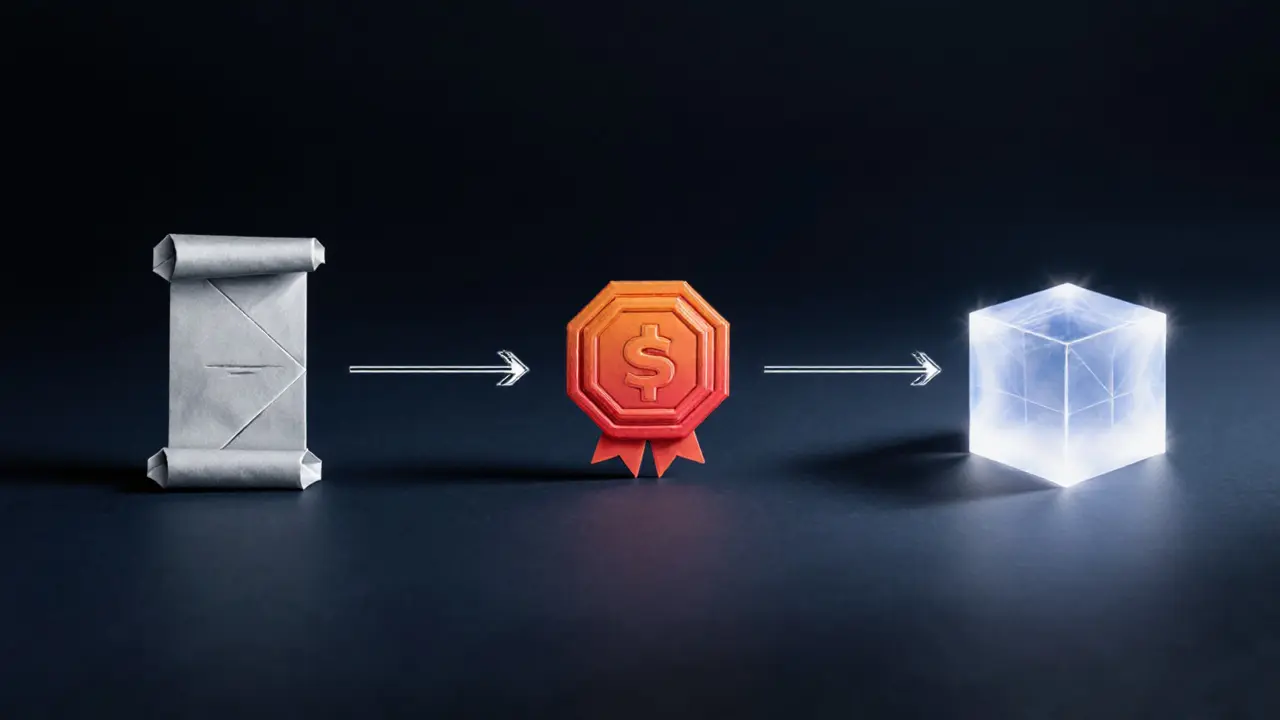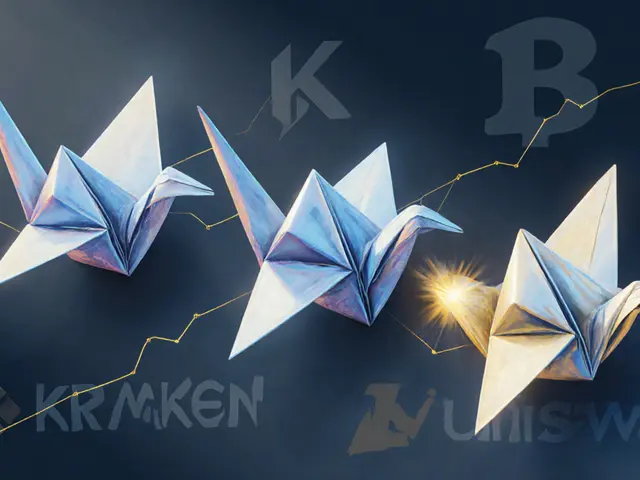Blockchain Transaction Signature Simulator
Transaction Data
Private Key
Signature Process
Click below to simulate the signature creation and verification steps:
Signature Details
When a blockchain node needs to confirm a transaction, digital signatures are cryptographic proofs that bind transaction data to the holder of a private key without revealing the key itself. They are the glue that lets a decentralized network trust a piece of data it never saw before. In this guide you’ll learn what a digital signature actually is, how it’s built on asymmetric cryptography, why ECDSA reigns supreme, and what the verification steps look like on a live blockchain.
Key Takeaways
- Digital signatures use a private‑public key pair to prove ownership without exposing the private key.
- Transaction data is first hashed; the hash combined with the private key creates a unique signature via ECDSA.
- Every node runs the same verification math using the sender’s public key, guaranteeing consensus.
- ECDSA’s small key size makes it fast and storage‑efficient, which is why Bitcoin, Ethereum and most other chains use it.
- Future upgrades (Schnorr, post‑quantum schemes) aim to keep verification cheap while adding privacy and scalability.
What Is a Digital Signature?
A digital signature is a mathematical construct that proves two things at once: the data hasn’t been tampered with, and it was approved by the owner of a specific private key. Think of it as a fingerprint that only the key holder can produce, yet anyone with the matching public key can check.
Asymmetric Cryptography in a Nutshell
Asymmetric (or public‑key) cryptography relies on a pair of numbers that are mathematically linked. The Private Key is a large random number kept secret by the user is used for signing, while the Public Key is derived from the private key and can be freely shared is used for verification. The link is one‑way: you can compute the public key from the private key, but not the reverse.
Step‑by‑Step: How a Blockchain Transaction Gets Verified
- Create the transaction data. This includes the sender address, recipient address, amount, nonce, gas fees, etc.
- Hash the data. The full payload is run through a cryptographic hash function (SHA‑256 for Bitcoin, Keccak‑256 for Ethereum). The result is a 32‑byte digest that uniquely represents the transaction.
- Sign the hash. Using the ECDSA Elliptic Curve Digital Signature Algorithm, the private key mathematically combines with the hash to produce a pair of numbers (r, s) that form the signature. The signature is attached to the transaction payload.
- Broadcast the signed transaction. Nodes receive the package, which now contains: the original data, the signature, and the sender’s public key (or an address that can be derived from it).
- Verify on each node. Every node repeats the hash step, then runs the ECDSA verification algorithm using the public key, the hash, and the (r, s) values. If the equation holds, the signature is valid; otherwise the transaction is rejected.
- Commit to the ledger. Only after passing verification does the transaction join the mempool, get picked by a miner/validator, and finally become a permanent block.

Why ECDSA Beats RSA and DSA for Blockchains
RSA needs key sizes of 2048bits or more to reach the security level of a 256‑bit elliptic curve. Bigger keys mean larger signatures, more bandwidth, and slower verification. ECDSA delivers comparable security with 256‑bit keys, which translates to 64‑byte signatures on Bitcoin. This compactness reduces storage pressure on the chain and speeds up node processing.
| Scheme | Typical Key Size | Signature Size | Verification Speed |
|---|---|---|---|
| ECDSA (secp256k1) | 256bits | 64bytes | Fast |
| RSA (2048‑bit) | 2048bits | 256bytes | Slower |
| EdDSA (Ed25519) | 256bits | 64bytes | Very fast (deterministic) |
| Schnorr (BIP‑340) | 256bits | 64bytes | Fast + linear aggregation |
Real‑World Applications Beyond Simple Transfers
Digital signatures power everything on a blockchain, not just coin moves. Smart contracts on Ethereum uses ECDSA signatures to authenticate function calls and state changes. Multi‑signature wallets require2‑of‑3 or 3‑of‑5 signatures before a transaction is considered valid, dramatically raising security for high‑value accounts. Supply‑chain platforms attach a signature to each product‑level certificate, letting auditors trace every handoff without trusting a central authority. Even cross‑chain atomic swaps rely on signatures to guarantee that either all legs of the trade finish together or none do.
Security Considerations & Best Practices
- Never expose the private key. Store it in hardware wallets or secure enclaves. If the key leaks, anyone can forge valid signatures.
- Use deterministic nonces. Re‑using the random number (k) in ECDSA leads to private‑key recovery. Modern libraries follow RFC6979 to generate k deterministically from the hash.
- Validate the full transaction structure. A valid signature alone doesn’t guarantee a transaction is safe-check gas limits, replay protection, and network rules.
- Watch for replay attacks. Some chains require chain‑specific domain separators to prevent a signature from being reused on a different network.
Future Trends: From Schnorr to Quantum‑Resistant Schemes
Bitcoin’s recent activation of Schnorr signatures (BIP‑340) adds linear aggregation, meaning several signatures can be merged into one, shaving off bytes and verification time. Meanwhile, research groups are testing threshold signatures that let a group of parties jointly produce a single signature without exposing individual keys.
Quantum computers threaten the hardness assumptions behind elliptic‑curve cryptography. Post‑quantum candidates like CRYSTALS‑Dilithium and FALCON are being trialed in testnets. Although deployment is years away, developers are already drafting migration paths to keep blockchains safe when quantum attacks become feasible.
Layer‑2 solutions (e.g., rollups, state channels) are also optimizing verification. By moving most contract execution off‑chain and only posting succinct proofs, they cut the number of on‑chain signature checks dramatically, boosting throughput without sacrificing trustlessness.
Quick Checklist for Developers
- Generate a strong, random private key using a reputable library.
- Derive the public key and address correctly (use the right curve parameters).
- Hash the exact transaction payload before signing.
- Sign with ECDSA (or the chain‑specific variant) following RFC6979.
- Attach the public key/address and signature to the broadcast payload.
- On verification, recompute the hash, run the ECDSA check, and reject if any step fails.

Frequently Asked Questions
Why can’t I reuse a signature for a different transaction?
A signature is bound to the exact hash of the transaction data. Changing the amount, recipient, or any field produces a different hash, so the old signature will fail verification.
Is ECDSA secure against modern attacks?
Yes, as long as the curve parameters (secp256k1) and key sizes remain unchanged and private keys are kept secret. The main risk comes from poor nonce handling or key leakage, not the algorithm itself.
What is the advantage of Schnorr over ECDSA?
Schnorr signatures are linear, so multiple signatures can be aggregated into a single proof. This reduces data size and verification load, which is useful for multi‑sig wallets and batch transactions.
Do I need to store the public key on-chain?
Typically the sender’s address (derived from the public key) is stored. Nodes can recover the full public key from the address and the signature during verification.
How soon will post‑quantum signatures replace ECDSA?
Most major blockchains estimate a 10‑15year horizon before quantum‑resistant algorithms become a must‑have. Pilot networks are already testing CRYSTALS‑Dilithium, but wide adoption will need careful migration planning.





Lana Idalia
Ever wondered why a digital signature feels like a whispered promise between strangers? It's a cryptographic handshake where the private key whispers the truth and the public key shouts the proof. This dance of math keeps the blockchain honest without ever revealing the secret. In a world full of noise, a signature is the rare moment of certainty. So next time you see a transaction, think of it as a tiny pact sealed in code.
Raj Dixit
Digital signatures are the backbone of crypto, and no one can deny their power.
Darrin Budzak
I love how signatures let us trust each other without ever needing to meet. It’s like a friendly nod that says, “I’ve got your back.” When the network validates a signature, it’s really just confirming that the sender cared enough to sign their intent. This low‑key reliability is what keeps the whole ecosystem chill.
Andrew McDonald
While most users skim the surface, the elegance of ECDSA lies in its compactness and speed. The algorithm’s subtlety is often underappreciated, yet it powers the most robust chains. Understanding the underlying math elevates a casual observer to a true connoisseur. 🙂
Enya Van der most
Let’s pump some energy into this conversation! Digital signatures aren’t just technical; they’re the superhero cape of decentralization. Think of every transaction as a bold stride forward, backed by a signature that screams confidence. Keep that momentum, and the blockchain will keep soaring!
Eugene Myazin
Hey folks, just wanted to add a quick take: signatures make cross‑border transfers feel like a friendly wave. No need for banks, no middlemen-just pure cryptographic trust. It’s a great example of tech bringing cultures together.
karyn brown
Honestly, if you still think signatures are just a fancy add‑on, you’re missing the point. They’re the gatekeepers that stop chaos from spilling into the ledger. Skipping proper signature checks is like leaving your front door wide open.
Rachel Kasdin
Signatures keep our national crypto assets safe and strong. No shortcuts, just pure security.
Noel Lees
I'm constantly amazed by how a simple pair of numbers can stop fraud across the globe 😊. The verification step is the silent watchdog that never sleeps.
Raphael Tomasetti
ECDSA’s 256‑bit curve offers a sweet spot between security and performance.
Jenny Simpson
Everyone’s hyped about signatures, but let’s not forget the drama behind the math. It’s a silent battle where each transaction fights for validation, and the signature stands as the lone hero braving the chaos. Without it, the blockchain would be a stage with no script-pure improvisation, and not the kind we crave.
Sabrina Qureshi
Wow!!! This guide really shines!!! The way it breaks down hashing, signing, and verification is just... spectacular!!! It’s like a bright lantern in the dark maze of cryptography!!! Keep the brilliant content coming!!!
Ron Hunsberger
When building on a blockchain, the first rule is to treat your private key like the most precious secret you own. Never store it in plain text on a server; use a hardware wallet or an encrypted enclave instead. Always generate the key with a reputable library that follows the secp256k1 standard, because custom implementations can introduce subtle bugs. Before you sign, verify that the transaction payload includes the exact nonce, gas limit, and chain ID you intend; any mismatch will invalidate the hash. Use a deterministic nonce generation method such as RFC6979 to avoid the catastrophic reuse of the random number k, which could expose your private key. After signing, keep the (r, s) pair alongside the transaction hash, but never reveal the private key alongside them. When broadcasting, make sure the sender’s address is correctly derived from the public key; otherwise nodes will reject the transaction outright. Each node will independently recompute the hash and run the ECDSA verification; this redundancy is what gives the network its trustlessness. If verification fails, double‑check that you didn’t accidentally alter the transaction data after signing. Remember to also validate the chain‑specific domain separator to protect against replay attacks across forks. For multi‑signature wallets, aggregate the signatures only after every participant has signed with their own nonce to preserve security. Keep your libraries up to date; many past vulnerabilities stemmed from outdated cryptographic code. Test the entire flow on a testnet before going live, because even a tiny ordering mistake can cause funds to be locked. Finally, document your signing procedure clearly for your team, so that future developers understand each step and don’t re‑introduce old mistakes. Following these practices will keep your signatures robust, your transactions smooth, and your assets safe.
Marie Salcedo
Great points! I especially love the reminder about using hardware wallets – simple steps like that make a huge difference for newcomers.